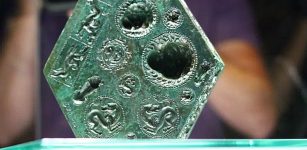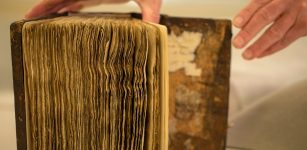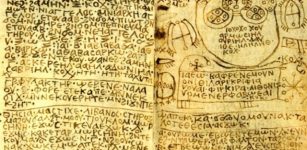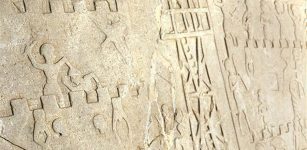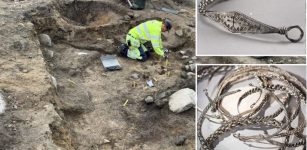Mysterious Tablet With Unknown Script Found In Vilnius Castle Puzzles Scientists
Jan Bartek - AncientPages.com - A remarkable discovery was made using a metal detector during an archaeological expedition in Vilnius castle in Lithuania. The archaeologists unearthed a rectangular strip of metal adorned with peculiar engravings. This finding was unexpected as the scientists had anticipated discovering nothing more than a rudimentary axe. Instead, they stumbled upon an enigmatic tablet inscribed with an unidentified script dating back to the 13th-14th century.
Credit: M. Kaminskas /LRT
This lead tablet is currently exhibited at the Palace of the Grand Dukes of Lithuania Museum. Its origin and script continue to baffle scientists due to their unfamiliarity with such artifacts and lack of knowledge about where it originated from.
The metal tablet, measuring nineteen centimeters in length, four centimeters in width, and nearly half a centimeter in thickness was firmly affixed to a wooden base.
“We tried to find a logical explanation for the markings: on the sides of the tablet, the beginning and the end were marked with crosses, as if they were marking the beginning and the end of the text,” Gintautas Striška, head of the Archaeology and Architecture Department at the Palace of the Grand Dukes of Lithuania Museum in Vilnius told the LRT News.
“The text is clearly composed of several lines. The top line seems to be written in two ways – signs and letters, and the bottom line has several more lines with various inscriptions,” he added.
“At the time, we thought that part of the text may have been written in ancient Greek. With the help of linguists, we saw that part of it could be translated as 'Algirdas Basileus' – that is, 'King Algirdas,'” said Striška.
According to researchers, the characters only resemble Greek letters, and there's a chance that the individual who etched them might have overlooked some details or merged multiple letters into one. This complicates the process of decoding the inscription.
The lead tablet might be pointing toward Grand Duke Algirdas, the ruler of Lithuania from 1345 to 1377. While 'Basileus' is a term used for the emperor in Byzantine culture, it was not a title that Algirdas held. Interestingly, though, in a letter penned to the Patriarch of Constantinople in 1370, he did refer to himself as Basileus. This was likely his way of asserting that he was an independent ruler with authority equal to that of the Byzantine Emperor.
There are many beautiful castles in Vilnius. Here, we see the Trakai Castle. Credit: Adobe Stock - Michele Ursi
“Therefore, such an inscription on the tablet is entirely plausible,” said Striška.“But the small plaque hides more secrets: when the restoration of the find began, it turned out that the reverse side of the plaque also had a writing.”
Credit: M. Kaminskas /LRT
The archaeologist suggests that a few words might be names. A well-preserved two-line inscription appears to read as Marem Byoyb, and other inscriptions nearby could also represent names. The intriguing inscription seems to have been written by multiple individuals. The top features meticulously carved symbols and uppercase letters, while the bottom showcases smaller, slightly distinct letters etched into soft metal.
See also: More Archaeology News
There is a possibility that the inscriptions on the plate are in various languages, which complicates its interpretation.
The researchers are inviting visitors and fellow researchers to share their insights on deciphering this text from the 13th to 14th centuries.
Written by Jan Bartek - AncientPages.com Staff Writer






